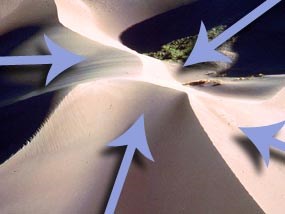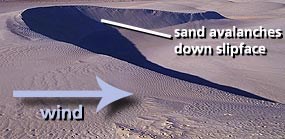
NPS/Patrick Myers 
NPS/Kris Illenberger Reversing DunesComprising the majority of the 30-square-mile dunefield, reversing dunes are the result of two opposing wind directions. The predominate wind direction is from the southwest, pushing the dunes in the dunefield toward the mountains, but storm winds off the mountains from the northeast sometimes flip the crest of the dunes backward, forming a sharp ridge.

NPS/Patrick Myers Star DunesStar dunes have three or more ridges descending from their summit, creating a star shape when viewed from above. 
NPS Star dunes form only in locations where there are multiple wind directions over the course of a year. At Great Sand Dunes, the large star dune complex in the northwest portion of the dunefield is the result of scattered wind directions from the shape of the nearby mountains. 
NPS Parabolic Dunes Much of the sand sheet is covered with vegetation. If strong winds erode a section of the vegetated sand (commonly referred to as a blowout), a parabolic dune may form. Leeward motion occurs if sand from the blowout is deposited on the opposite slope of the parabolic dune. Vegetation holds the "arms" of the dune in place as the leeward "nose" of the dune migrates forward toward the main dunefield. Parabolic dunes are common in the sand sheet southwest of the main dunefield. 
NPS In the foreground of this aerial photo, on the sand sheet, parabolic dunes are slowly migrating toward the main dunefield. Vegetation on the valley floor causes them to become parabolic dunes rather than barchan dunes (below). 
NPS Barchan Dunes 
NPS/Patrick Myers Nebkha Dunes Nebkha dunes (also known as coppice dunes) are simple dunes that form around vegetation, either on the sand sheet or in cottonwood trees along Medano Creek and Sand Creek. Shrubs or trees begin to gather windblown sand; as the sand gets deeper, the plants also grow taller, allowing more sand to gather around them. |
Last updated: May 1, 2025
